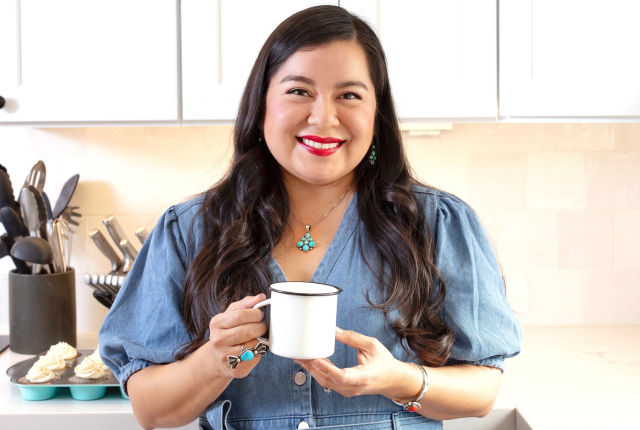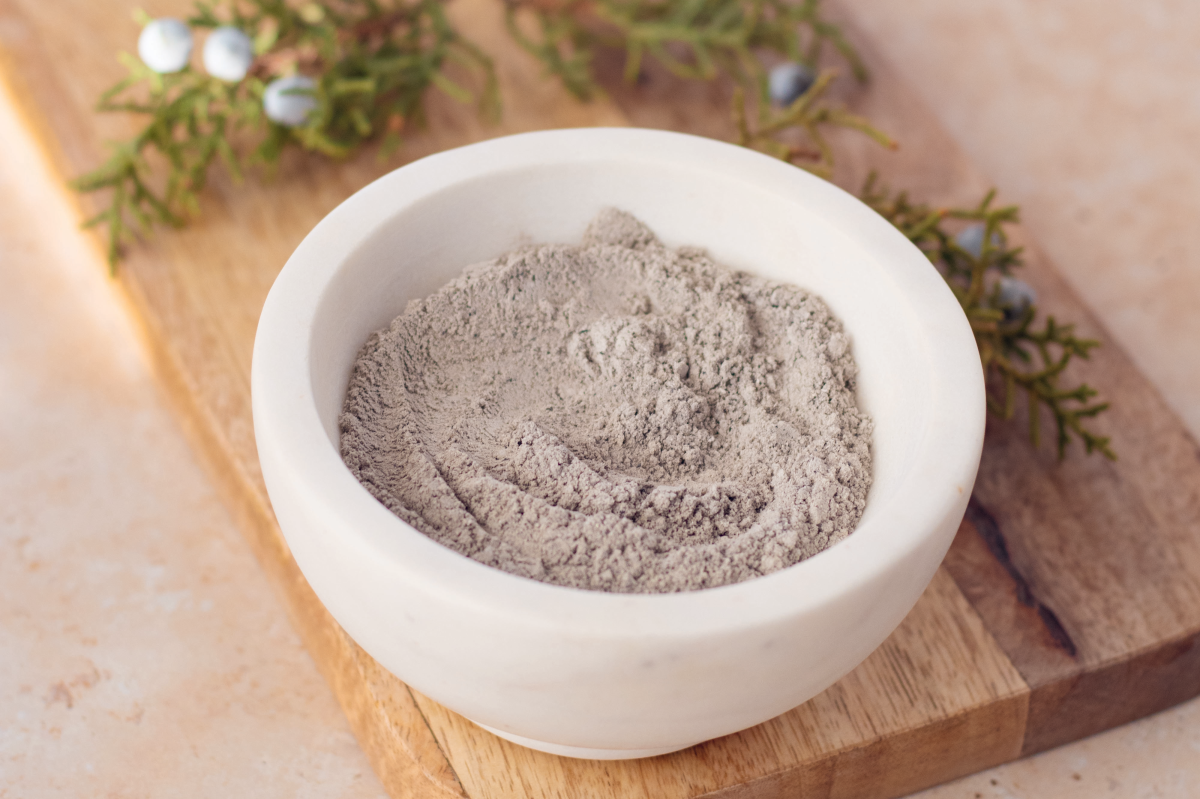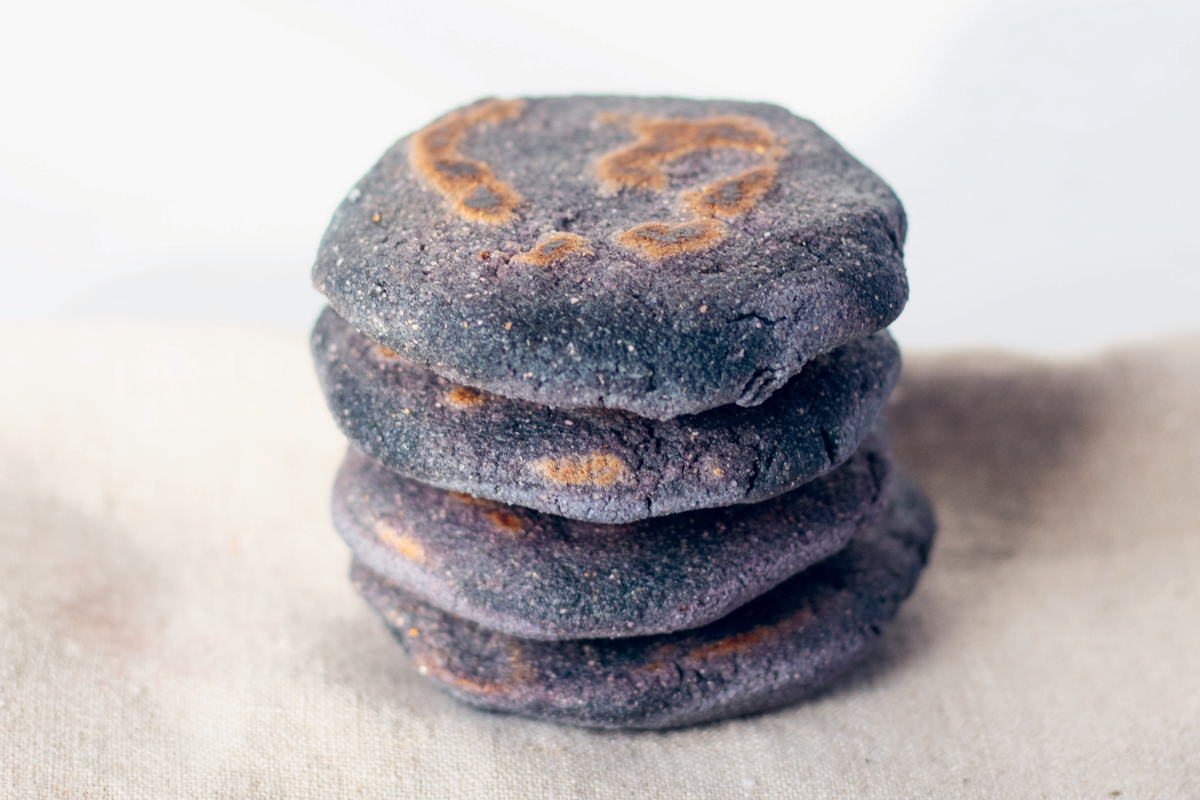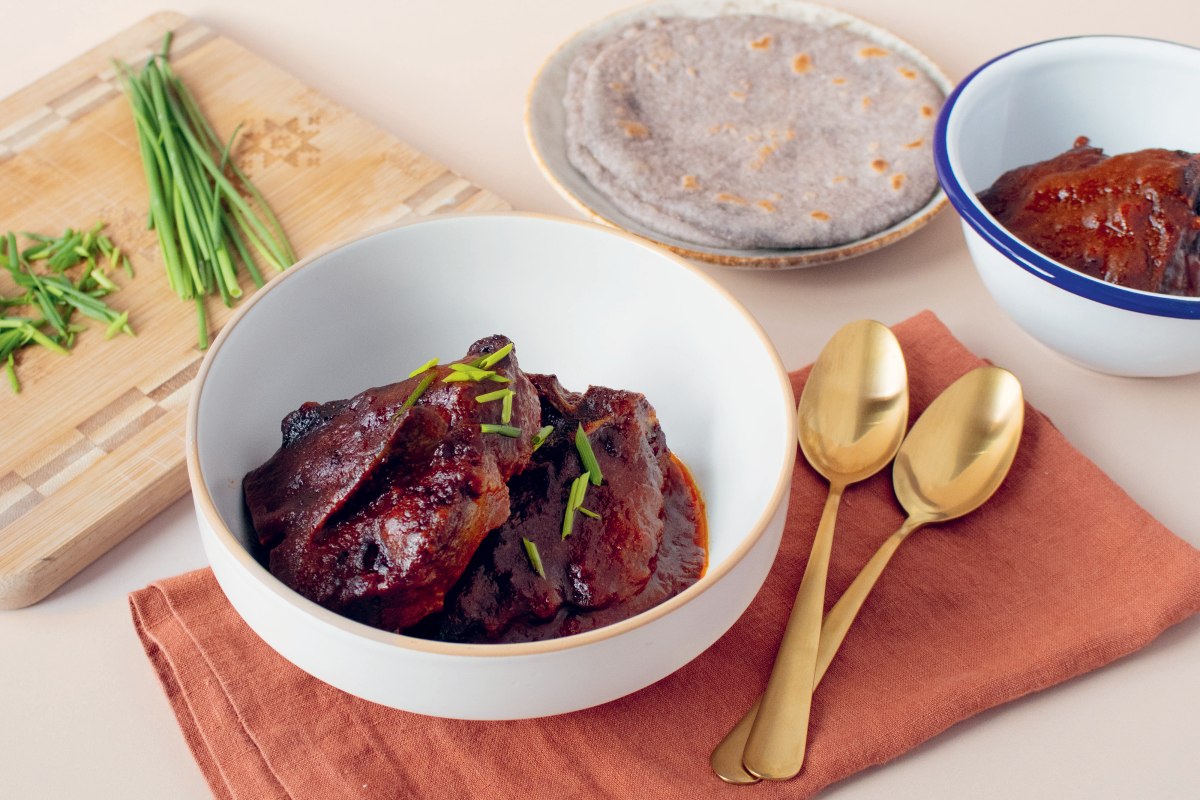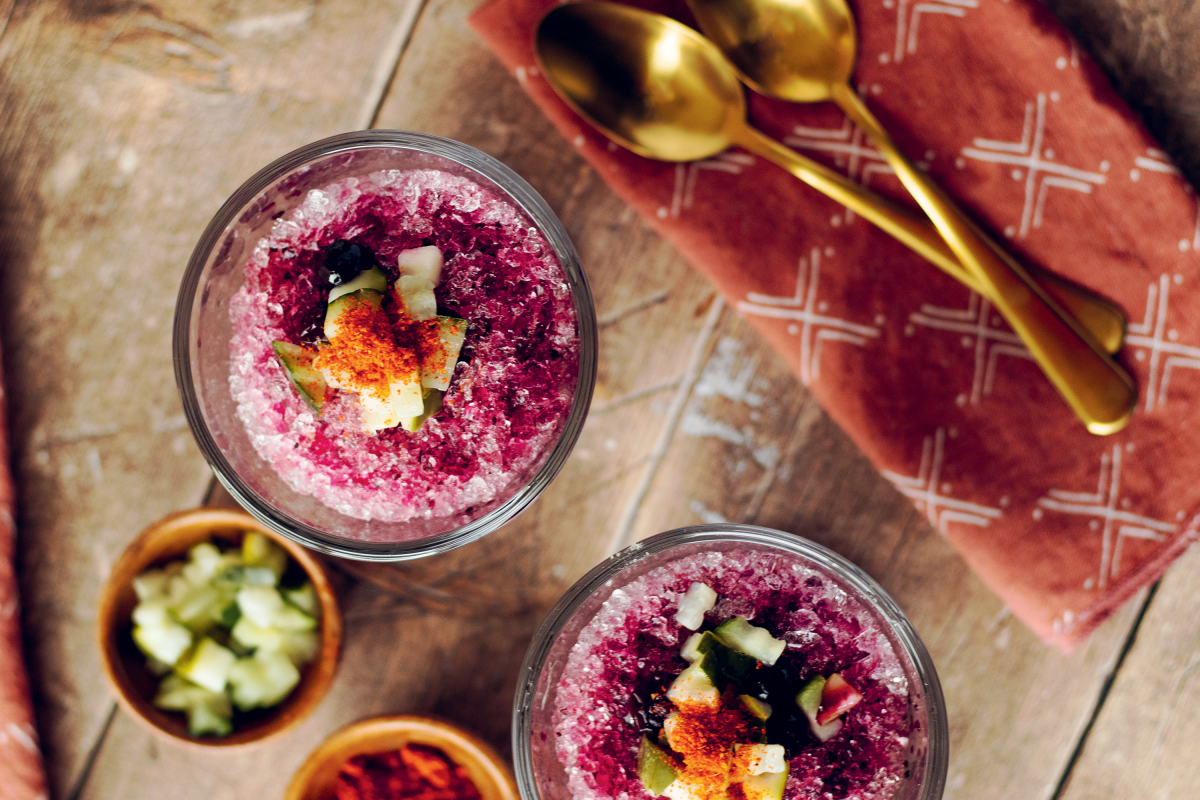ALANA YAZZIE WANTS YOU TO KNOW how ayoo łikan (delicious) Navajo food is. In her first cookbook, The Modern Navajo Kitchen: Homestyle Recipes that Celebrate the Flavors and Traditions of the Diné, Yazzie, a marketing specialist turned lifestyle blogger, hones her talent for showcasing Navajo culture into 60 beautifully crafted recipes for staples including mutton stew, blue corn mush, and sumac berry pudding. The book incorporates traditional uses of culturally important ingredients, as well as more recent food introductions like Spam, a product introduced via federal food programs, and piccadilly, a salty and sweet iced dessert that has become wildly popular in Navajo communities over the last decade.
Without being too esoteric, The Modern Navajo Kitchen showcases Navajo culinary creativity, resilience, and playfulness with flavor and cooking techniques. It’s a bright and cheery contrast to how Diné people and food are usually portrayed: as survivors of historical violence and hardship.
“When it comes to Navajo food in the mainstream media, you just have the more popular foods like frybread and mutton sandwiches,” Yazzie says. “But truly, there’s a lot more to it on top of survival foods.”
In making this cookbook, Yazzie explored the intricacies of corn variety and use and the science behind culinary ash. “I was learning and relearning what Navajo cuisine is—a lot of self-exploration,” she says. “I realize there is a need to have more written recipes for Navajo food.”
Known as the Fancy Navajo on Instagram and Facebook, Yazzie has a sizable social media following, and her food posts have sparked a lot of questions from the urban Diné community about Navajo foods and written recipes, which inspired her to start working on the cookbook 10 years ago.
Perhaps what’s most impressive is that Yazzie—who isn’t a trained chef—also did the food styling and photography for her book. I don’t know of any other cookbook authors who’ve done all that and worked in their traditional language. It’s obvious how important sharing these recipes is to Yazzie.
The juniper tree is common in the Southwest, and juniper ash, or gad bee łeeshch’iih, is a staple in the Navajo pantry. However, it is not something you can buy at your local grocery store. It is typically made at home or purchased from Navajo food purveyors on the Navajo Nation. Traditionally, it is made outside in large batches over an open fire with the ashes stored for use throughout the year. Since the juniper branches are usually wild-foraged in isolated areas, avoid selecting branches in high-traffic areas because they may have been treated with pesticides or other unknown chemicals. A common Navajo teaching is to “take only what you need,” so be mindful when foraging juniper branches. Juniper ash is often used when cooking with blue cornmeal. I like to call juniper ash a Navajo superfood. It helps break down the cornmeal to make it more digestible and infuses the cornmeal with nutrients like zinc, iron, and magnesium. Most importantly, it provides a source of calcium. The ash also deepens the blue color of blue cornmeal. If you cook without it, then the color of the blue cornmeal will be more of a purplish blue. (It is also called Navajo baking powder because it acts like an alkaline solution when dissolved.) Juniper ash can also be found at local flea markets, trading posts on the Navajo reservation, and sometimes online.
SAFETY NOTE: This is a modern approach to making a small batch of juniper ash. Take the necessary precautions to ensure this is done safely. Juniper ash must be created outside and away from anything that could catch fire, as there will be open flames and smoke. I do this in my backyard at least 15 feet away from my house on ground that has gravel. Avoid making juniper ash on windy days.
- 4 or 5 juniper branches (about 12 inches long) or about 12 ounces juniper tree sprigs with berries removed
- Special equipment: campfire grill, kitchen torch, medium sifter
Yields ½ cup
- If using juniper branches, cut off all the sprigs with scissors and discard any large branches. Clean each sprig by lightly rinsing it with cool water for 1 to 2 minutes. Remove and discard any juniper berries and excess debris. Let the branches dry completely for at least 24 hours.
- Line a sheet pan with aluminum foil and set it on the ground where you’ll prepare the juniper ash outside. Place the campfire grill grate directly over the sheet pan, so that the entire sheet pan is underneath the grill grate without any obstructions. You should be able to easily remove the sheet pan from underneath the grill grate.
- Place 3 to 5 sprigs on top of the grill grate. Then, with a kitchen torch, fully ignite the juniper sprigs so that they burn completely. The juniper embers will fall onto the sheet pan underneath the grill grate. Repeat, working in batches of 3 to 5 sprigs, being careful to control the open flames. The branch portion of the juniper sprig will mostly remain on the grill while the burned cedar embers will fall onto the sheet pan.
- Once all the ashes have cooled for 8 to 10 minutes, carefully remove the sheet pan from underneath the grill grate and discard any debris left on the top of the grill.
- Carefully scoop the ashes into the sifter with a metal spoon and sift the ash into a medium bowl. Store the juniper ash in an airtight glass container in a cool place, such as a pantry, for up to six months.
This recipe has only four ingredients, yet it packs a lot of flavor. Traditionally, these are made outside on a hot flat stone that acts like a griddle. Elders like to dip these blue corn patties into mutton stew.
- 2 teaspoons juniper ash
- ½ teaspoon salt
- 1½ cups roasted blue cornmeal
Makes 6 servings
1. In a medium saucepan, combine the juniper ash and ½ cup of water and mix with a wooden spoon. Bring the mixture to a boil over medium heat and let it boil for 3 to 4 minutes, until the mixture turns a gray color and is bubbling hot. Remove from the heat and add the salt. Mix well.
2. Stir in the cornmeal, ½ cup at a time. Once all the cornmeal is incorporated, add ¼ cup cool water and continue to mix until a thick dough forms.
3. Transfer the dough to a medium heat-safe bowl and let it cool for 3 to 4 minutes, until it is cool enough to handle.
4. Heat a medium pan or cast-iron skillet over medium heat for 8 minutes.
5. While the pan is preheating, mix the dough with your hands for 2 minutes and then divide the dough into 6 balls. Flatten each ball into a round patty, 3 inches in diameter and ¼ inch thick. Place the patties on a plate and cover with a damp paper towel.
6. Cook the patties for 4 to 5 minutes on each side, until slightly toasted and deep blue in color. If the patties start to toast quickly, reduce the heat to medium-low. Serve warm with stew.
Braised red chile mutton stew is a contemporary take on mutton stew. It infuses the flavors of New Mexico red chile and Navajo white cornmeal into a soft and tender stew. This is the perfect stew to make on weekends.
- 8 dried mild or hot New Mexico red chiles
- 3 cups hot water
- 6 garlic cloves, peeled
- 2 pounds mutton or lamb loin chops
- 2 teaspoons extra-virgin olive oil
- 1 teaspoon salt
- 2 tablespoons brown sugar
- 2 tablespoons white cornmeal
Makes 4 servings
1. Place a rack in the middle of the oven and preheat the oven to 300°.
2. Prepare the dried chiles by giving them a quick rinse under warm water for about 1 minute each. Remove and discard the stems and seeds.
3. Place the rinsed chiles and hot water in a blender. Let the mixture sit for 5 minutes. Then add the garlic and blend on medium speed for 3 to 4 minutes, until fully blended. Strain the mixture through a fine-mesh strainer into a medium bowl and set it aside. Discard any seeds and sediment in the strainer.
4. Prepare the lamb by trimming any excess fat with a knife. I like to leave on 10 to 15 percent of the fat.
5. Warm a large pan or cast-iron skillet over medium-high heat for 4 to 5 minutes. Add the olive oil. Add the lamb chops and sear on each side for 2 minutes. Place the lamb chops into a 9-inch square baking dish and set aside.
6. Pour the reserved red chile sauce into the pan used to sear the meat and bring it to a boil over medium heat. Whisk in the salt and brown sugar and continue to boil the sauce for 5 minutes. Reduce the heat to low.
7. Slowly whisk the cornmeal into the sauce, a tablespoon at a time. Cook, stirring continuously, for 5 minutes, until the sauce is thickened.
8. Pour the red chile sauce over the lamb chops and place in the oven for 3 hours, until the meat is soft and easily pulls away from the bone. The internal temperature of the meat should be 170°.
Piccadilly is a modern dessert that has gained popularity in recent years on the Navajo Nation. It’s a syrupy shaved ice topped with chopped pickles and sprinkled with Kool-Aid powder. It is typically sold at local flea markets and urban Native markets. The sweet and sour flavors may seem off-putting, but they go well together. The first time I tried this dessert, I couldn’t help but notice that the sprinkled Kool-Aid powder was similar to the flavor of ground sumac berries, which are naturally lemony and tart. This recipe is a reimagined version of piccadilly that uses traditional Navajo sumac berries and a homemade berry syrup that is perfect for the summertime.
- 1 cup blueberries
- ¼ cup sugar
- 4 cups shaved or finely crushed ice
- ¼ cup diced (¼ inch) pickles
- 1 teaspoon ground sumac berries
Makes 4 servings
1. In a small saucepan, combine blueberries, sugar, and 1 cup of water. Bring the mixture to a boil over medium heat, then reduce the heat to medium-low and simmer for 5 to 8 minutes, until the mixture starts to thicken and the water has reduced to half its volume.
2. Remove the pan from the heat and let the berry sauce cool completely, 15 to 20 minutes. Once cooled, transfer to a blender and blend on high speed for 2 to 3 minutes, until it reaches a smooth consistency. Pour the berry sauce into a small bowl with a lid and store in the refrigerator until ready to use. This can be made 1 to 2 days in advance.
3. Add a cup of shaved ice to four small bowls. Drizzle with 3 to 4 tablespoons of the berry sauce, so that the ice is completely covered. Top with 1 to 2 teaspoons of the pickles and sprinkle with ¼ teaspoon of the ground sumac berries. Serve immediately.
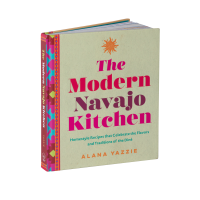
Published in 2024, The Modern Navajo Kitchen (Wellfleet Press) celebrates modern and traditional Navajo cuisine with 60 mouthwatering recipes and vivid images by author Alana Yazzie.


